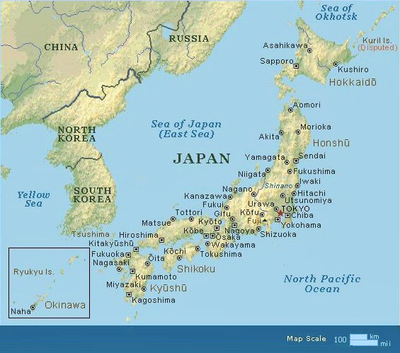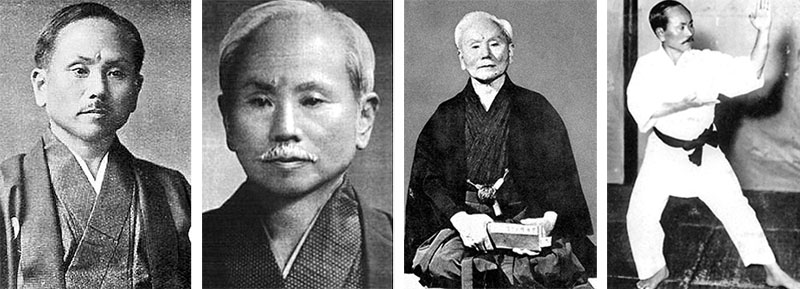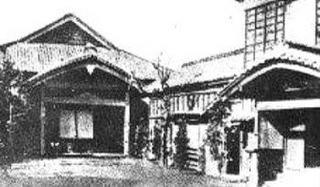About Karate
Karate is a form of unarmed combat employing a wide range of punching and kicking techniques. There are no weapons involved in practising karate and the term 'karate' literally means 'empty hand'; (Kara 'empty', Te 'hand'). Only the hands and feet are used for blocking and striking. There are many distinctive styles of karate each with their own characteristics such as emphasising speed, power and hip rotation. Other styles concentrate on competitions, self defence or various applications of techniques. Ultimately, as we shall see, if we trace what we today call 'karate' back to its early beginings we will find ourselves looking to India and China...
History
The similarities in styles are a consequence of some of the shared histories karate has with other martial arts. The common source is attributed to a Buddhist monk called Bhodidharma who in the 5th century travelled from India to China to teach Zen Buddhism. The study of Zen required considerable mental concentration as well as physical stamina. He devised a way of combining Chinese and Indian Kenpo (fighting) with Yoga and a system of physical training to refine techniques. The monks of the Shaolinssu were particularly adept to this and as they travelled through China, the different fighting techniques were adapted to the local conditions. With this adaptation, different styles of martial art were beginning to take shape.

Karate Emerges
Okinawa lies between China and Japan and was a refuge for those fleeing civil wars in China. Chinese fighting methods were passed on to Okinawans who adapted them with their own form of unarmed combat. Chinese movements tended to be smoother and rounded than the Okinawan and combined to become commonly known as Tang Hand or 'Chinese Hand'.
Okinawa was occupied by the Japanese Satsuma in the 17th century who forbade the carrying of weapons and Tang Hand flourished secretly as an illegal means of self defence. It was refined to even strike through the body armour of their aggressors which accounts for some of the emphasis of developing wood breaking techniques within some styles.
Because of the great secrecy surrounding Tang Hand, training took place in small groups and this inevitably led to some differentiation in styles. Some carried an emphasis on 'hard' technique, others on 'soft'.

Who founded Karate?
Okinawan born Funakoshi Gichin was first to introduce Tang Hand to Japan at a demonstration at the Butoku-Den in Kyoto in 1916. In 1922 he moved to Tokyo and began his lifetime's work – the establishment of 'Shotokan' Karate. He also studied Japanese Jujitsu and other martial arts. He was by all accounts a quiet, thoughtful and deeply sincere man who believed strongly that those who practice karate should do so with a sense of humility, discipline and respect, both for themselves and others. He is quoted as saying that: "When the man of Tao receives his first dan (first degree black belt), he will bow his head in gratitude. Upon receiving his second dan, he will bow his head and his shoulders. Upon receiving his third dan, he will bow to the waist and quietly walk alongside the wall so that people will not see him or notice him".
It was in 1936, after modifying his own style that he decided to rename it to 'Karate'. Gichin referred to Karate as Karate-do. In doing this he was encouraging students to regard Karate not as a sport or simply a form of unarmed combat but as a 'martial art' with a close emphasis on the building and perfecting of character. The word do translates roughly as 'way', 'path' or 'discipline'. In this context 'do' should be thought of in the sense of something to be followed, with the journey leading towards an intended goal or final destination. What he was attempting to achieve was the alignment of his 'Karate' with the Budo traditions of Japan (Budo - 'way of the martial arts'). These traditions were an absolutely integral part of Japanese history and culture. Funakoshi Gichin spent the rest of his life living in Japan and working to develop and spread Karate all over the world. He died in 1957.

What is 'Shotokan'?
'Shotokan' was the name of the first official training hall (dojo) built by Funakoshi in 1939 at Mejiro (see picture opposite). It was destroyed in 1945 as a result of allied bombing. 'Shoto' which translates as 'pine-waves' (the movement of pine needles when the wind blows through them), was Funakoshi's pen-name. He used this in his poetic and philosophical writings and in messages to his students. The Japanese 'Kan' means 'House' or 'Hall'. In honour of their sensei, Funakoshi's students created a sign reading Shōtō-kan, which they placed above the entrance of the hall where Funakoshi taught.
So, as we have learned, it was Funakoshi who created the name 'Karate' to describe his interpretation of various blocks, kicks, punches and stances which were derived from Tang Hand. His particular style and technique came to be known as 'shotokan karate' – but it was not the only one. Other styles of Karate proliferated and this remains the situation up to the present day. This proliferation of style demonstrates that Karate is not a fixed form but rather something still very much in a state of evolution. The main characteristics of Shotokan karate to that of other styles is that it emphases a low stance with wide foot positions. This allows a considerable use of hip power in generating techniques. Shotokan also places great emphasis on Kata (formal exercises). Other styles will adopt emphasis on other areas and techniques and it is this which differentiates them from Shotokan.
